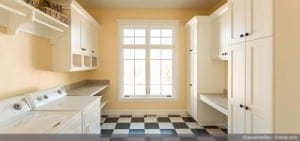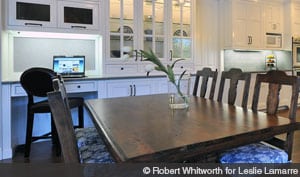Creative Ways to Market Odd Spaces
Originally posted on http://realtormag.realtor.org/home-and-design/feature/article/2016/10/creative-ways-market-odd-spaces
What do you say to buyers who look at a listing’s floor plan only to focus on the large space labeled “dining room” that they know they’ll rarely use? The fact is, buyers and sellers may have vastly different perceptions about how they want to live in the same home. But that doesn’t have to be a deal-killer.
Part of the problem stems from how architects and builders label rooms on plans, says Chicago-based commercial interior designer Mary Cook. “Rooms get designated and labeled for specific purposes, so it’s difficult to break that perception and think about them as spaces that are something else,” she says.
But as a real estate professional, you can help make a difference with the descriptions you write in your marketing materials and with the way you talk about space in a listing. Clever copy can provide just the right inspiration for buyers who might have otherwise turned away.
A huge log-burning fireplace dominating a living room can be recast as a “built-in entertainment center to gather around,” suggests designer Lonnie Unger of Fredman Design Group in Chicago. Just be sure to make concrete suggestions that buyers can visualize, even before they zoom in on photos or step through the front door.
Whether you’re working with sellers who have outdated notions of their listing’s assets or with buyers who can’t imagine how they’d use a space that doesn’t seem to apply to their lifestyle, we’ve amassed some talking points that can help you smooth out the conflict. Here are five examples to inspire you to help your clients imagine what can be, rather than allowing what is to become a deal breaker.
1. What it is: Oversized walk-in closet
The big closets that came along with the McMansion trend were often outfitted with shelves, rods, cabinets, and even storage islands and seating space. As conspicuous consumption falls out of favor, these spaces may seem like a waste for some buyers, who’d rather spend their square footage elsewhere.
What it can be: “Practical laundry space adjacent to master bedroom.” Because large walk-in closets are usually well illuminated and may even have a window for daylight, they offer numerous possibilities. How about an upstairs laundry by the bedrooms? After all, this is where most of the dirty clothing originates, so why should home owners trudge down to the basement with their hampers? If the space is large enough, a built-in ironing board or folding counter could work well, and closet shelving can be repurposed as a place to keep laundry supplies. If there’s leftover space, home owners could carve out a corner for crafts. Jennifer Ames, a salesperson with Coldwell Banker Residential Brokerage in Chicago, notes that this idea is often appealing because few home owners want to give up a whole bedroom for such activities these days.
2. What it is: Built-in kitchen desk
As kitchens became gathering hubs with more equipment, counters, and seating, many home owners wanted a desk with wall plugs and phone jacks where they could pay bills, schedule family activities, and place a large desktop computer and landline. But the downsizing of computer equipment, greater use of laptops, tablets, and cell phones, and the pervasiveness of Wi-Fi throughout a home has resulted in fewer people demanding this feature, says designer Leslie Lamarre of TRG Architecture + Interior Design in San Mateo, Calif..
What it can be: “Bonus kitchen storage space with universal design counter.” Because desk space is usually lower than traditional counters, it can be an awkward space to stage. But as more home owners look to open up the cooking experience to the whole family, they might benefit from having a prep space that can be used by kids or adults who may be more comfortable sitting. Have sellers pack up that old desktop and stage the space with colorful ramekins and a playful, sturdy cutting board. Desk bookshelves can be transformed with a few nice cookbooks and cabinets can easily be reimagined as pantry storage space, since there’s rarely enough of that in most kitchens anyway, Lamarre says. If sellers want to make some easy upgrades, they might consider adding pull-out racks that permit easy access to kitchen gadgets and dry goods. A light can be installed to switch on automatically when the pantry opens, which is always a nice touch.
3. What it is: Finished basement or attic
Maybe you’re working with buyers who are looking to scale back and cut expenses. The last thing they want is another finished level they have to furnish, particularly one that they have to pay to heat and cool.
What it can be: “Flexible guest quarters with separate zoned HVAC system.” First, investigate whether or not the space in question is already on a separate HVAC system. Even if it’s not, you can emphasize that extra floors can usually be closed off when not in use by switching an existing system to separate zoned units. Connecticut architect Duo Dickinson, author of Staying Put: Remodel Your House to Get the Home You Want (The Taunton Press), pegs the cost at between $500 and $2,000, depending on square footage and the system chosen. “Then, you just shut the door when nobody’s there,” he says. Help buyers imagine how this space can work for visiting elderly parents who are still able to climb stairs, grown children who return periodically, and houseguests who crave privacy. Home owners might also be tempted by the possibility of renting the space out on short-term rental sites such as Airbnb.
4. What it is: Large, formal dining room
If a listing’s layout has a classic plan, that often means there’s a separate dining space on the main floor. Today’s buyers may consider that a white elephant for their lifestyle, except for major holidays, says Dickinson. And even then, some prefer to entertain casually in a big kitchen.
What it can be: “Multifunctional, main-floor entertainment center.” Of course, some home owners choose to widen the opening from the kitchen to the dining room for a larger combination space, or even take down a non-loadbearing wall between the rooms for a more wide-open flow. But you can also suggest the cheaper option of simply putting a new spin on the space. Replace the dining room table and seating with big comfy chairs, a giant screen, and black-out shades, and the space may even appeal more to buyers than a basement home theater would, says Dickinson. “It’s also closer to the kitchen to serve snacks,” he says. If they like, home owners can still keep a table on hand for special occasions, Ames says.
5. What it is: Maid’s room with bathroom
Like the big traditional dining room, a small living space for help dates back to another era. And today it may seem like a cloistered, wasted space for home owners, unless they have a caregiver living with them for young children or an elderly parent.
What it can be: “Kids’ separate play space or mud room.” These rooms are often located near the kitchen and a door to the outside. Tailor your suggestions based on the needs of the family. Those with small kids might appreciate a rainy-day playroom with a conveniently located spot to wash up before meals. Ames suggests sellers can stage this space with a big toy bin and other accessories to play up this idea. Parents with older children might appreciate thinking of this space as a sort of locker room with a bench and individual storage spaces for each family member, Unger suggests.
Once sellers have put their home on the market, it’s time for them to stop thinking about the space as theirs. And there’s no need to let a lack of imagination keep buyers from saying yes to a home that meets all their other needs. As a real estate professional, you can help your clients be more creative with staging, smart showing, and savvy listing copy.



Recent Comments